
(a)
Interpretation:
The structural formula for the given compound has to be drawn.
Concept introduction:
Nomenclature of esters of carboxylic acids:
The acyl group bonded to
The naming of an ester of a
(a)
Explanation of Solution
The name of the compound is given below:
Dimethyl carbonate
From the name, it is clear that two methyl groups are attached to oxygen atoms in the compound and the parent ester group is carbonate.
Thus, the structure of the compound is given below:
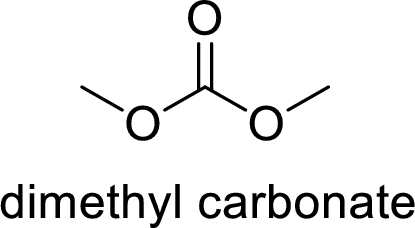
(b)
Interpretation:
The structural formula for the given compound has to be drawn.
Concept introduction:
Nomenclature of nitriles:
The numbering 1 can be given to the nitrile carbon atom and add nitrile to end of the
(b)
Explanation of Solution
The name of the compound is given below:
The functional group is nitrile and benzene ring is attached to it.
Thus, the structure of the compound is given below:
Benzo nitrile
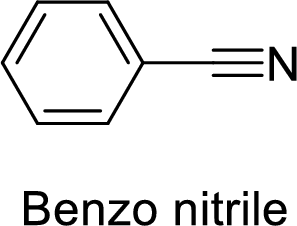
(c)
Interpretation:
The structural formula for the given compound has to be drawn.
Concept introduction:
Nomenclature of esters of carboxylic acids:
The acyl group bonded to
The naming of an ester of a carboxylic acid is done by naming alkyl or aryl group bonded to oxygen first followed by the name of the acid in which the suffix –ic acid is replaced by the suffix –ate.
(c)
Explanation of Solution
The name of the compound is given below:
Isopropyl-3-methylhexanoate
The alkyl group attached on oxygen atom is the isopropyl group and the parent chain is the methylhexanoate.
Thus, the structure of the compound is given below:

(d)
Interpretation:
The structural formula for the given compound has to be drawn.
Concept introduction:
Nomenclature of esters of carboxylic acids:
The acyl group bonded to
The naming of an ester of a carboxylic acid is done by naming alkyl or aryl group bonded to oxygen first followed by the name of the acid in which the suffix –ic acid is replaced by the suffix –ate.
(d)
Explanation of Solution
The name of the compound is given below:
Diethyl oxalate
From the name, it is clear that two ethyl groups are attached to oxygen atoms in the compound and the parent ester group is oxalate.
Thus, the structure of the compound is given below:
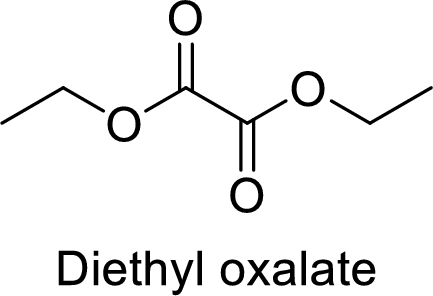
(e)
The structural formula for the given compound has to be drawn.
Concept introduction:
Nomenclature of esters of carboxylic acids:
The acyl group bonded to
The naming of an ester of a carboxylic acid is done by naming alkyl or aryl group bonded to oxygen first followed by the name of the acid in which the suffix –ic acid is replaced by the suffix –ate.
(e)
Explanation of Solution
The name of the compound is given below:
Ethyl (Z)-2-pentenoate
The alkyl group attached on oxygen atom is the ethyl group and the parent chain is the pentenoate. The double bond is having E configuration.
Thus, the structure of the compound is given below:

(f)
Interpretation:
The structural formula for the given compound has to be drawn.
Concept introduction:
Nomenclature of anhydrides:
The nomenclature of anhydride involves replacement of the word acid with anhydride. In the case of mixed anhydrides, both acids should be named.
(f)
Explanation of Solution
The name of the compound is given below:
Butanoic anhydride
From the butanoic acid, acid part can be replaced with an anhydride group.
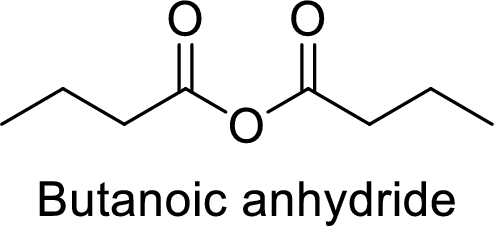
(g)
Interpretation:
The structural formula for the given compound has to be drawn.
Concept introduction:
Nomenclature of amides and imides:
The acyl group bonded to a nitrogen atom is the functional group of an amide.
The naming of an amide can be done by giving the suffix –oic acid from the IUPAC name of the parent acid and adding –amide.
The location of the alkyl or aryl group attached on nitrogen atom in an amide is indicated by ‘N-‘
The indication “ N,N-di-“ is used for two identical alkyl or aryl groups on nitrogen atom
(g)
Explanation of Solution
The name of the compound is given below:
Dodecanamide:
The functional group is amide and the acyl group attached is the dodecane group.
Thus, the structure of the compound is given below:

(h)
The structural formula for the given compound has to be drawn.
Concept introduction:
Nomenclature of esters of carboxylic acids:
The acyl group bonded to
The naming of an ester of a carboxylic acid is done by naming alkyl or aryl group bonded to oxygen first followed by the name of the acid in which the suffix –ic acid is replaced by the suffix –ate.
(h)
Explanation of Solution
The name of the compound is given below:
Ethyl-3-hydroxybutanoate
The alkyl group attached on oxygen atom is the ethyl group and the parent chain is the butanoate and a hydroxyl group is present in the third position.
Thus, the structure of the compound is given below:
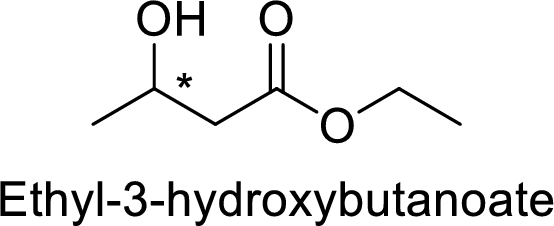
(i)
The structural formula for the given compound has to be drawn.
Concept introduction:
Nomenclature of acid chlorides:
The nomenclture of acid chlorides can be done by replacing –oic acid with –oyl chloride.
(i)
Explanation of Solution
The name of the compound is given below:
Octanoyl chloride
The acid group from the octanoic acid will be replaced by acid chloride group.
Thus, the structure of the compound is given below:
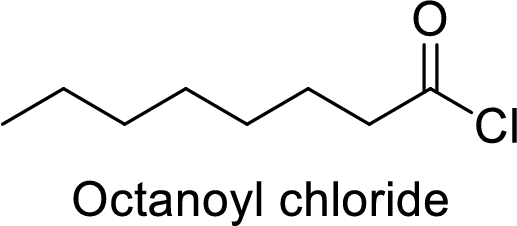
(j)
The structural formula for the given compound has to be drawn.
Concept introduction:
Nomenclature of esters of carboxylic acids:
The acyl group bonded to
The naming of an ester of a carboxylic acid is done by naming alkyl or aryl group bonded to oxygen first followed by the name of the acid in which the suffix –ic acid is replaced by the suffix –ate.
(j)
Explanation of Solution
The name of the compound is given below:
Diethyl cis-1,2-cyclohexanedicarboxylate
The alkyl group attached on oxygen atom are two ethyl groups and the parent chain is the dicarboxylate and a cyclohecxane group is present in the 1,2 position.
Thus, the structure of the compound is given below:

(k)
The structural formula for the given compound has to be drawn.
Concept introduction:
Nomenclature of acid chlorides:
The nomenclture of acid chlorides can be done by replacing –oic acid with –oyl chloride.
(k)
Explanation of Solution
The name of the compound is given below:
Methanesulfonyl chloride
The acid group from the methanesulfonic acid will be replaced by acid chloride group.
Thus, the structure of the compound is given below:
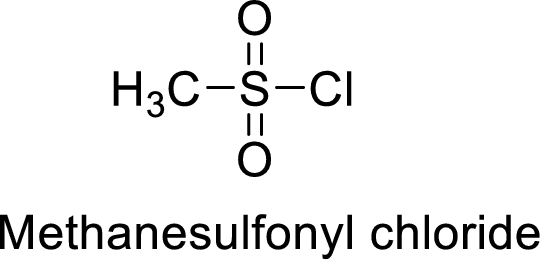
(l)
The structural formula for the given compound has to be drawn.
Concept introduction:
Nomenclature of acid chlorides:
The nomenclture of acid chlorides can be done by replacing –oic acid with –oyl chloride.
(l)
Explanation of Solution
The name of the compound is given below:
p-Toluenesulfonyl chloride
The acid group from the p-toluenesulfonic acid will be replaced by acid chloride group.
Thus, the structure of the compound is given below:
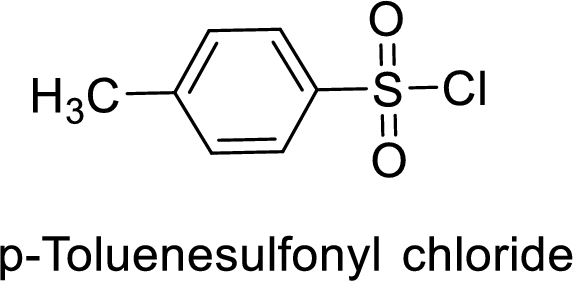
Want to see more full solutions like this?
Chapter 18 Solutions
ORGANIC CHEMISTRY-OWL V2 ACCESS
- Steps and explanation please. Add how to solve or target similar problems.arrow_forwardWould the following organic synthesis occur in one step? Add any missing products, required catalysts, inorganic reagents, and other important conditions. Please include a detailed explanation and drawings showing how the reaction may occur in one step.arrow_forwardThis organic molecule is dissolved in an acidic aqueous solution: OH OH A short time later sensitive infrared spectroscopy reveals the presence of a new C = O stretch absorption. That is, there must now be a new molecule present with at least one C = O bond. In the drawing area below, show the detailed mechanism that could convert the molecule above into the new molecule. Videos 849 Explanation Check C Click and drag to start dwing a structure. # 3 MAR 23 Add/Remove steparrow_forward||| 7:47 ull 57% ← Problem 19 of 48 Submit Curved arrows are used to illustrate the flow of electrons. Use the reaction conditions provided and follow the curved arrows to draw the product of this carbocation rearrangement. Include all lone pairs and charges as appropriate. H 1,2-alkyl shift +arrow_forwardWould the following organic synthesis occur in one step? Add any missing products, required catalysts, inorganic reagents, and other important conditions. Please include a detailed explanation and drawings showing how the reaction may occur in one step.arrow_forwardBelow is the SN1 reaction of (S)-3-chlorocyclohexene and hydroxide (OH). Draw the missing curved arrows, lone pairs of electrons, and nonzero formal charges. In the third box, draw the two enantiomeric products that will be produced. 5th attempt Please draw all four bonds at chiral centers. Draw the two enantiomeric products that will be produced. Draw in any hydrogen at chiral centers. 1000 4th attempt Feedback Please draw all four bonds at chiral centers. 8. R5 HO: See Periodic Table See Hint H Cl Br Jid See Periodic Table See Hintarrow_forwardShow that a molecule with configuration π4 has a cylindrically symmetric electron distribution. Hint: Let the π orbitals be equal to xf and yf, where f is a function that depends only on the distance from the internuclear axis.arrow_forward(a) Verify that the lattice energies of the alkali metal iodides are inversely proportional to the distances between the ions in MI (M = alkali metal) by plotting the lattice energies given below against the internuclear distances dMI. Is the correlation good? Would a better fit be obtained by plotting the lattice energies as a function of (1 — d*/d)/d, as theoretically suggested, with d* = 34.5 pm? You must use a standard graphing program to plot the graph. It generates an equation for the line and calculates a correlation coefficient. (b) From the graph obtained in (a), estimate the lattice energy of silver iodide. (c) Compare the results of (b) with the experimental value of 886 kJ/mol. If they do not agree, explain the deviation.arrow_forwardCan I please get help with #3 & 4? Thanks you so much!arrow_forwardarrow_back_iosSEE MORE QUESTIONSarrow_forward_ios
 Introduction to General, Organic and BiochemistryChemistryISBN:9781285869759Author:Frederick A. Bettelheim, William H. Brown, Mary K. Campbell, Shawn O. Farrell, Omar TorresPublisher:Cengage Learning
Introduction to General, Organic and BiochemistryChemistryISBN:9781285869759Author:Frederick A. Bettelheim, William H. Brown, Mary K. Campbell, Shawn O. Farrell, Omar TorresPublisher:Cengage Learning
